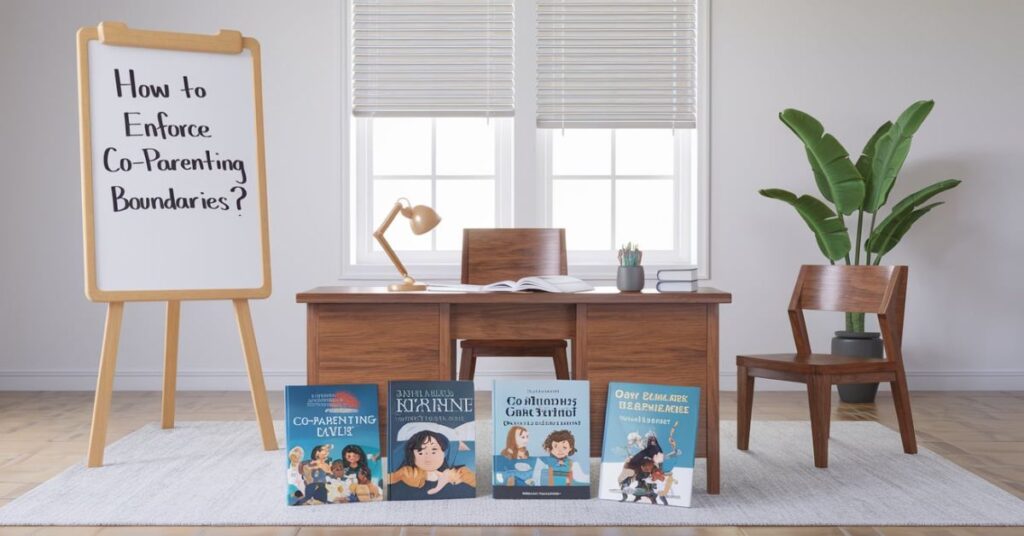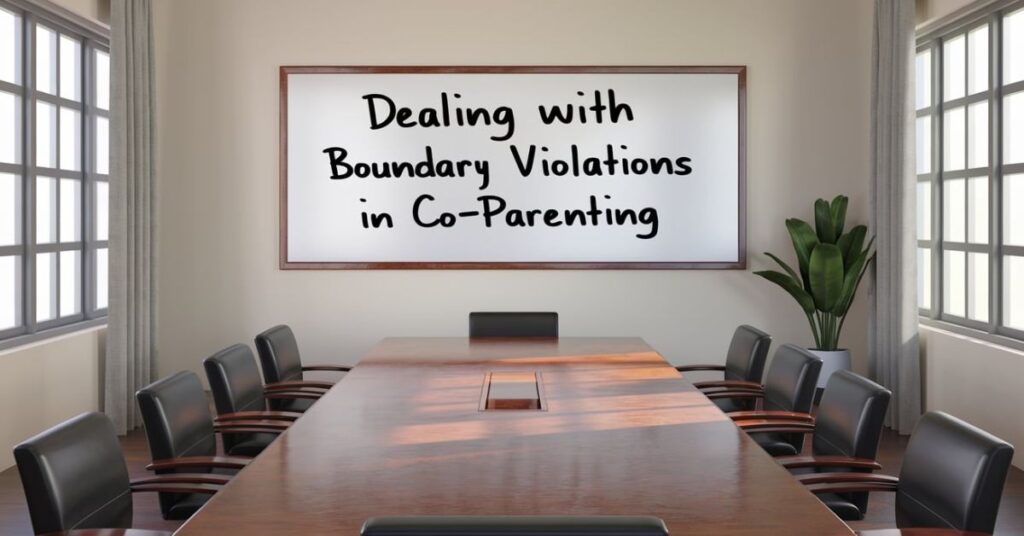Co-parenting can be tricky. But a solid list of co-parenting boundaries can make it easier. These boundaries help create a stable environment for your kids. They also make working with your ex smoother.
Let’s dive into the key co-parenting boundaries every parent should know. This list of co-parenting boundaries covers all the important areas. From communication to finances, we’ve got you covered.
Setting these co-parenting boundaries isn’t about winning. It’s about creating a healthy situation for your children. So, let’s explore this essential list of co-parenting boundaries.
Communication Boundaries
Good communication is crucial in co-parenting. Your list of co-parenting boundaries should start here. Choose a main way to communicate, like email or a co-parenting app.
Set rules for how often you’ll talk. Some co-parents check in daily. Others prefer weekly updates. Find what works for you both. This is a key item on your list of co-parenting boundaries.
Keep talks focused on the kids. Avoid old relationship issues. If things get heated, take a break. These communication rules are vital in any list of co-parenting boundaries.
Physical and Virtual Space Boundaries
Respect for space is important in co-parenting. Add this to your list of co-parenting boundaries. Agree on rules for entering each other’s homes. Maybe wait in the car during drop-offs.
Think about social media too. You might unfriend each other. Or agree on what to post about the kids. This is often overlooked in a list of co-parenting boundaries.
Decide what items stay at each house. And what travels with the kids. This reduces conflicts. It’s an important part of your list of co-parenting boundaries.
Parenting Time Boundaries

Clear schedules are key in co-parenting. Include this in your list of co-parenting boundaries. Make a detailed parenting schedule. Include regular visits, holidays, and special days.
Be flexible when needed. But respect the schedule. If changes are needed, say so early. This schedule is a crucial part of your list of co-parenting boundaries.
Focus on quality time with your kids. Don’t use this time for errands. This is an often forgotten item in a list of co-parenting boundaries.
Financial Boundaries
Money matters can cause big conflicts in co-parenting. Start by deciding how you’ll handle major expenses. Will you split them 50/50? Or based on income? Get it in writing to avoid confusion later.
Set up a system for tracking shared expenses. A spreadsheet or co-parenting app can be helpful. Keep all receipts and document everything to avoid disputes.
Consider opening a joint account just for child-related expenses. This can simplify things and reduce arguments about money. Just make sure to set clear rules for how this account will be used.
Boundaries around New Partners
New relationships can complicate things. Include this in your list of co-parenting boundaries. Agree on when to introduce new partners to the kids. Many experts say wait until it’s serious.
Set rules for new partners’ roles. They shouldn’t discipline the kids. Or make big decisions about them. This is a key part of any list of co-parenting boundaries.
New partners aren’t replacement parents. Respect both bio parents’ roles. Add this to your list of co-parenting boundaries to avoid conflicts.
Boundaries with Extended Family

Family can help or cause tension. Include this in your list of co-parenting boundaries. Set clear rules with grandparents, aunts, and uncles. They should respect your co-parenting choices.
Decide how to handle family events. Will both parents go? Or will you take turns? This is often forgotten in a list of co-parenting boundaries.
Try to keep connections with both families. It’s good for the kids. But stick to your list of co-parenting boundaries.
Personal Boundaries
Don’t forget about yourself. Add this to your list of co-parenting boundaries. Set limits on sharing personal info with your ex. It’s okay to keep some things private.
Make time for self-care. Co-parenting can be stressful. Find ways to relax. This is a vital part of your list of co-parenting boundaries.
It’s okay to say no sometimes. You don’t have to agree to everything. Include this in your list of co-parenting boundaries.
Read this Blog: Balancing Mom Life: Essential Tips for FamousParenting Momlife
The Importance of Flexibility in Co-Parenting Boundaries
While boundaries are crucial, flexibility is equally important. Be willing to adjust boundaries as circumstances change. Maybe your work schedule shifts, or one of your moves. Be open to revisiting and revising your agreements.
The goal is to create a stable environment for your kids. Sometimes that means bending a little on your boundaries. Flexibility doesn’t mean being a pushover. It means being willing to problem-solve together for the good of your children.
Regularly check in with each other to see if your current boundaries are still working. If not, be open to making changes. A flexible approach can lead to more harmonious co-parenting in the long run.
How to Enforce Co-Parenting Boundaries?

Setting boundaries is one thing, enforcing them is another. Be clear and consistent. Don’t let things slide one day and then get upset the next. Consistency helps everyone understand what to expect.
If a boundary is crossed, address it calmly and promptly. Don’t let resentment build up. A simple, “Hey, remember we agreed on X” can often do the trick.
If repeated violations occur, consider mediation or legal help. Sometimes a neutral third party can help resolve ongoing issues. Enforcing boundaries isn’t about punishment, it’s about maintaining a healthy co-parenting relationship.
The Role of Legal Agreements in Co-Parenting Boundaries
Legal agreements can provide a solid foundation for co-parenting boundaries. Consider including key boundaries in your custody agreement or parenting plan. This might cover communication methods, decision-making processes, and dispute resolution.
Legal agreements aren’t set in stone. You can modify them as your situation changes. Just make sure any changes are properly documented and agreed upon by both parties.
Even with legal agreements, try to resolve issues amicably when possible. Court should be a last resort, not your go-to solution. A cooperative approach is usually best for everyone involved, especially the children.
Teaching Children about Boundaries in Co-Parenting
Kids benefit from understanding boundaries too. Explain your co-parenting boundaries to your kids in age-appropriate ways. For example, “Mommy and Daddy have different houses now, but we both love you very much.”
Model good boundary-setting for your kids. Show them how to communicate clearly and respectfully about their needs and limits. This is a valuable life skill they’ll carry into adulthood.
kids shouldn’t be caught in the middle. Don’t use them to relay messages or gather information about your ex. Keep them out of adult issues and focus on making them feel loved and secure.
The Impact of Technology on Co-Parenting Boundaries
Technology can be both a help and a hindrance in co-parenting. Consider using co-parenting apps to manage schedules, expenses, and communication. These can help keep everything organized and reduce conflicts.
Be mindful of how you use social media. Avoid posting negative comments about your ex or sharing too much about your kids online. Set clear boundaries about what can and can’t be shared on social platforms.
Technology shouldn’t replace face-to-face communication entirely. Sometimes a quick phone call can resolve issues more effectively than a string of texts. Find a balance that works for your co-parenting situation.
Dealing with Boundary Violations in Co-Parenting

Even with the best intentions, boundary violations can happen.
How to handle them:
- Stay calm: Don’t react in anger. Take a deep breath and approach the situation rationally.
- Communicate clearly: Explain which boundary was crossed and why it’s important.
- Listen: Try to understand why the violation occurred. There might be a misunderstanding.
- Problem-solve: Work together to find a solution that respects both parties’ needs.
- Follow through: If the violation continues, be prepared to enforce consequences.
The Role of Professional Help in Establishing Co-Parenting Boundaries
Sometimes, co-parenting feels like a tough puzzle. You might struggle to fit all the pieces together. That’s when a professional can step in to help. They can offer fresh ideas and new ways to solve problems.
A family therapist or mediator knows all about co-parenting. They’ve seen many families work through similar issues. They can guide you and your ex to create boundaries that work for everyone. Their outside perspective can shed light on things you might have missed.
Professional help doesn’t mean you’ve failed. It shows you’re committed to doing what’s best for your kids. An expert can teach you skills to communicate better and resolve conflicts. With their help, you can build a strong foundation for successful co-parenting.
Co-Parenting Boundary Checklist
Use this checklist to ensure you’ve covered all key areas:
- Communication method and frequency agreed upon.
- Parenting schedule established.
- Financial responsibilities are clearly defined.
- Rules for introducing new partners set.
- Boundaries with extended family were discussed.
- Personal space and privacy limits are established.
- Technology and social media guidelines are in place.
- Process for handling disputes agreed upon.
- Plan for regular boundary check-ins and revisions.
Common Co-Parenting Boundary Pitfalls
| Pitfall | Solution |
| Inconsistent enforcement | Be firm and consistent with boundaries |
| Letting emotions drive decisions | Take time to calm down before responding |
| Using kids as messengers | Communicate directly with your co-parent |
| Badmouthing the other parent | Keep negative comments to yourself |
| Ignoring the need for flexibility | Be willing to adjust boundaries as needed |
Final Words
A good list of co-parenting boundaries is essential. It helps create a stable environment for your kids. It also makes co-parenting smoother for you and your ex.
Your list of co-parenting boundaries should cover all key areas. From communication to finances, from personal space to new relationships. Remember to be clear, consistent, and flexible.
With a solid list of co-parenting boundaries, you can navigate co-parenting more easily. Keep focusing on what’s best for your kids. That’s the true purpose of any list of co-parenting boundaries.
Frequently Asked Questions
What are the most important co-parenting boundaries?
Communication, parenting time, and financial boundaries are crucial for effective co-parenting.
How often should co-parents communicate?
It depends on your situation, but many co-parents find that weekly check-ins work well.
How do you set boundaries with a difficult co-parent?
Be clear, consistent, and document everything. Consider using a mediator if needed.
Should co-parents be friends on social media?
It’s generally best to limit social media connections to reduce potential conflicts.
How do you explain co-parenting boundaries to kids?
Use age-appropriate language and focus on reassuring them of both parents’ love and commitment.

Zade Smith is a Proficient writer on TechsBlip, dedicated to delivering high-quality content that bridges the gap between medical research and accessible, reader-friendly guidance. With a keen interest in promoting healthy lifestyles and disease prevention, Zade’s writing offers expert insights, actionable tips, and evidence-based information to help readers make informed decisions about their health and wellness

